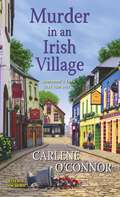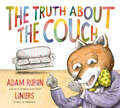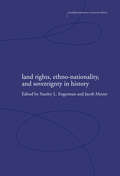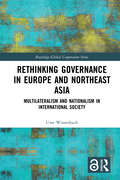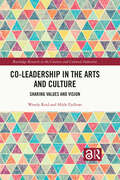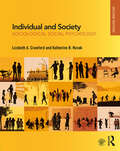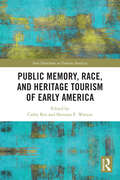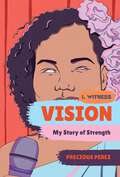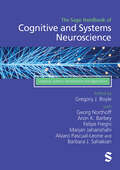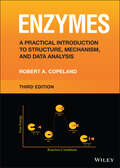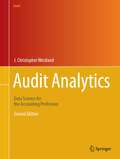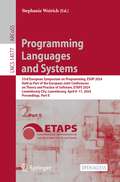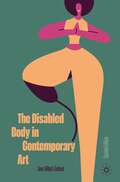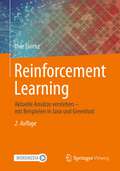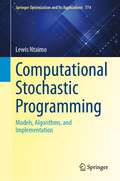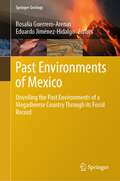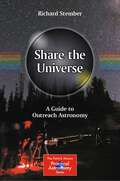- Table View
- List View
Redefining Instructional Leadership: The Skills And Energy Required Of An Instructional Leader
by John R. Jones Misty HenryThe Girl in the Lifeboat (Novels of the Titanic, #2): A Novel Of The Titanic
by Eileen Enwright Hodgetts"SOS TITANIC TO ALL SHIPS. SINKING HEAD DOWN 41.46 N 50.14 W. COME AS SOON AS POSSIBLE"She has survived the sinking of the Titanic; will she survive the White Star Line's attempts to silence her? April 1912: Runaway aristocrats Poppy and Daisy Melville sign on as stewardesses for the Titanic's maiden voyage. After their harrowing rescue by the Carpathia, they are forbidden from disembarking in New York and sent back to England with the other survivors of the Titanic's crew.Soon they learn that the White Star Line will stop at nothing, including murder, to prevent the truth of the disaster's cause from emerging.Daisy, a beautiful young woman used to getting her way, harbors a secret that raises the stakes even higher. Where was she while the ship was sinking and why is she stalked from New York back to England?Poppy must protect her sister from a vengeful murderer by uncovering the real cause of the sinking.The Girl in the Lifeboat is the second book in Eileen Enwright Hodgetts' "Novels of the Titanic" series. She intricately weaves fact and fiction to expose a disturbing truth about the shipwreck that changed the world. If you like dynamic heroines, little-known but meticulously researched facts, and a touch of romance, then you'll find yourself completely immersed into the aftermath of the Titanic.
Freedom in Your Relationship with Food: An Everyday Guide (Freedom In Your Relationship With Food Ser.)
by Myra LewinMurder in an Irish Village: A Charming Irish Cozy Mystery (An Irish Village Mystery #1)
by Carlene O'Connor&“If Janet Evanovich and Maeve Binchy wrote a book together, [this] would be the result . . . Siobhán O&’Sullivan is a character to savor.&”—Laurien Berenson, author of Game of Dog Bones In the small village of Kilbane, County Cork, Ireland, Naomi&’s Bistro has always been a warm and welcoming spot to visit with neighbors, enjoy some brown bread and tea, and get the local gossip. Nowadays twenty-two-year-old Siobhán O&’Sullivan runs the family bistro named for her mother, along with her five siblings, after the death of their parents in a car crash almost a year ago. It&’s been a rough year for the O&’Sullivans, but it&’s about to get rougher. One morning, as they&’re opening the bistro, they discover a man seated at a table, dressed in a suit as if for his own funeral, a pair of hot pink barber scissors protruding from his chest. With the local garda suspecting the O&’Sullivans and their business in danger of being shunned—murder tends to spoil the appetite—it&’s up to feisty redheaded Siobhán to solve the crime and save her beloved brood. &“Kicks off a new series in splendid fashion! If you love cozy mysteries and traveling, then give Murder in an Irish Village a try. You&’ll feel like you&’ve stepped into Ireland as you turn the pages.&”—Fresh Fiction &“A smart whodunnit in an idyllic locale. I dare you not to be charmed by sleuth Siobhán and her siblings, the O&’Sullivan Six.&”—Barbara Ross, author of A Maine Clambake Mystery Series &“A delightful, funny, fast-paced romp of a book.&”—Isis Crawford, author of A Mystery with Recipes Series
The Truth About the Couch
by Adam RubinPssst! Hey. I'm here to tell ya what the furniture police don't want you to know... Listen close. I'll explain everything. <P><P> Most people think couches are just for sitting, or maybe napping, and don't give it a second thought. But did you know couches can go berserk if you don't feed them a steady diet of coins, cell phones, and remote controls? And did you know some couches are grown on a farm? (Where do you think the term couch potato comes from?) Some come from two chairs who love each other very much, and some are actually aliens in disguise. And that's just the tip of the iceberg... <P><P> This laugh-out-loud send-up of conspiracy theories brings Adam Rubin's trademark zany humor together with the richly expressive artwork of Macanudo creator Liniers to explore the totally, completely true (really! maybe?) history of the world's most beloved—and misunderstood—item of furniture. <p> <b>New York Times Bestseller</b>
Land Rights, Ethno-nationality and Sovereignty in History (Routledge Explorations in Economic History)
by Stanley L. Engerman Jacob MetzerEngerman is one of the world's best known economic historiansThe book analyses the thorny issue of property rights and ethno-nationality across a range of countriesThe approach uses econometrics
Rethinking Governance in Europe and Northeast Asia: Multilateralism and Nationalism in International Society (ISSN)
by Uwe WissenbachThis book explores how nationalism and multilateralism transform international society and global governance. It does so by comparing the governance model of the EU – a constitutionalised and increasingly polycentric form of multilateralism – with Northeast Asia. There nationalist administrations have resisted multilateral commitments and are locked into rivalries instead of pursuing a regional project.Both Europe and Northeast Asia can be seen as success stories of the late 20th/ early 21st centuries, but by having followed different approaches to international governance. The book traces these two trajectories through critical junctures in history to how both regions have dealt with the contemporary challenges of the financial crisis and climate change. During the financial crisis, Europe’s multilateral economic and monetary architecture revealed profound weaknesses whilst national policies allowed much of Northeast Asia to escape the worst of it. On climate change the European Union (EU) has developed effort-sharing governance models to reduce emissions, while Northeast Asian countries are relying on greening national industrial policy. The book argues that global governance has to find the balance between multilateralism and nationalism in order to find collaborative approaches to global challenges.This book provides a fresh take on the EU and on Northeast Asia and develops innovative concepts of international society and polycentric governance. Thus, it will be of considerable interest to researchers and students of global governance, international relations, EU and Asia Studies.
Co-Leadership in the Arts and Culture: Sharing Values and Vision (Routledge Research in the Creative and Cultural Industries)
by Wendy Reid Hilde FjellværThis book is about co-leadership: A leadership practice and structure often found in arts organizations that consist of two or three executives who bridge the art and business divide at the top.Many practitioners recognize this phenomenon but the research on this topic is limited and dispersed. This book assembles a coherent overview and presents new insights of the field. While co-leadership is well institutionalized in the West, it is also criticized for management’s constraint of artistic autonomy and for its pluralism that dilutes leadership clarity. However, co-leadership also personifies the strategic objectives of art, audiences, organization, and community, by addressing plural logics – navigating the demands of artistic vision and organizational stability. It is an integrating solution. The authors investigate its specifics in the arts, including global practice and its interdisciplinary nature. The theoretical frame of plural leadership supports their empirical explorations of the dynamics within the co-leadership relationship and with organizational stakeholders. Data includes the voices of co-leaders, artists, staff, and board members from arts organizations in Canada and Norway. Their abductive reflection generates a stimulating research experience.By viewing co-leadership in action, not as a study of static theories, the book will appeal not only to students and researchers but also resonate with practitioners in arts and cultural management and assist them to work with co-leadership and to manage its tensions.
Individual and Society: Sociological Social Psychology
by Lizabeth A. Crawford Katherine B. NovakUnlike other texts for undergraduate sociological social psychology courses, this text presents the three distinct traditions in sociological social psychology—symbolic interactionism, social structure and personality, and group processes and structures—and emphasizes the different theoretical frameworks within which social psychological analyses are conducted within each research tradition. With this approach, the authors make clear the link between sociological social psychology, theory, and methodology. Students will gain a better understanding of how and why social psychologists trained in sociology ask particular kinds of questions; the types of research they are involved in; and how their findings have been, or can be, applied to contemporary societal patterns and problems.This new, second edition includes the latest research on topics related to current events and changing societal patterns; more detailed discussions on intersectionality, social media, and contemporary social movements; as well as a new concluding chapter that asks students to reflect on what they have learned about sociological social psychology and its applicability to contemporary social issues. Engaging exercises and group activities are also embedded within in each chapter to enhance students’ understanding of key concepts, theories, methods and research findings within the field and how they relate to everyday life.
Public Memory, Race, and Heritage Tourism of Early America (New Directions in Tourism Analysis)
by Cathy Rex and Shevaun E. WatsonThis book addresses the interconnected issues of public memory, race, and heritage tourism, exploring the ways in which historical tourism shapes collective understandings of America’s earliest engagements with race.It includes contributions from a diverse group of humanities scholars, including early Americanists, and scholars from communication, English, museum studies, historic preservation, art and architecture, Native American studies, and history. Through eight chapters, the collection offers varied perspectives and original analyses of memory-making and re-making through travel to early American sites, bringing needed attention to the considerable role that tourism plays in producing—and possibly unsettling—racialized memories about America’s past. The book is an interdisciplinary effort that analyses lesser-known sites of historical and racial significance throughout North America and the Caribbean (up to about 1830) to unpack the relationship between leisure travel, processes of collective remembering or forgetting, and the connections of tourist sites to colonialism, slavery, genocide, and oppression.Public Memory, Race, and Heritage Tourism of Early America provides a deconstruction of the touristic experience with racism, slavery, and the Indigenous experience in America that will appeal to students and academics in the social sciences and humanities.
Vision: My Story Of Strength (I, Witness #0)
by Precious PerezA young activist opens a window into her journey to become a professional musician and leader for the disabled community. Ever since Precious Perez was a child, she has loved to sing. Born and raised outside Boston, her family joked that she’d eventually study at Berklee College of Music. But when a high school music teacher advocated for Precious’s talent, her dream became a reality. Precious was born two-and-a-half months premature and weighed just one pound. Her eyes did not develop fully, and she is blind. Growing up, most people focused on what Precious could not do because of her disability. With her teacher’s support, Precious realized all the things she could do with her disability—starting with attending Berklee. With a voice that is both accessible and engaging, Vision brings forward an empowering first-person account of a woman finding strength and purpose in her disability. The I, Witness series delivers compelling narrative nonfiction by young people, for young people.
The Sage Handbook of Cognitive and Systems Neuroscience: Cognitive Systems, Development and Applications
by Gregory J. Boyle Georg Northoff Aron K. Barbey Felipe Fregni Marjan Jahanshahi Alvaro Pascual-Leone Barbara J. SahakianCognitive neuroscience is the interdisciplinary study of how cognitive and intellectual functions are processed and represented within the brain, which is critical to building understanding of core psychological and behavioural processes such as learning, memory, behaviour, perception, and consciousness. Understanding these processes not only offers relevant fundamental insights into brain-behavioural relations, but may also lead to actionable knowledge that can be applied in the clinical treatment of patients with various brain-related disabilities. This Handbook examines complex cognitive systems through the lens of neuroscience, as well as providing an overview of development and applications within cognitive and systems neuroscience research and beyond. Containing 35 original, state of the art contributions from leading experts in the field, this Handbook is essential reading for researchers and students of cognitive psychology, as well as scholars across the fields of neuroscientific, behavioural and health sciences. Part 1: Attention, Learning and Memory Part 2: Language and Communication Part 3: Emotion and Motivation Part 4: Social Cognition Part 5: Cognitive Control and Decision Making Part 6: Intelligence
The Sage Handbook of Cognitive and Systems Neuroscience: Cognitive Systems, Development and Applications
by Gregory J. Boyle Georg Northoff Aron K. Barbey Felipe Fregni Marjan Jahanshahi Alvaro Pascual-Leone Barbara J. SahakianCognitive neuroscience is the interdisciplinary study of how cognitive and intellectual functions are processed and represented within the brain, which is critical to building understanding of core psychological and behavioural processes such as learning, memory, behaviour, perception, and consciousness. Understanding these processes not only offers relevant fundamental insights into brain-behavioural relations, but may also lead to actionable knowledge that can be applied in the clinical treatment of patients with various brain-related disabilities. This Handbook examines complex cognitive systems through the lens of neuroscience, as well as providing an overview of development and applications within cognitive and systems neuroscience research and beyond. Containing 35 original, state of the art contributions from leading experts in the field, this Handbook is essential reading for researchers and students of cognitive psychology, as well as scholars across the fields of neuroscientific, behavioural and health sciences. Part 1: Attention, Learning and Memory Part 2: Language and Communication Part 3: Emotion and Motivation Part 4: Social Cognition Part 5: Cognitive Control and Decision Making Part 6: Intelligence
Enzymes: A Practical Introduction to Structure, Mechanism, and Data Analysis
by Robert A. CopelandENZYMES A complete and approachable introduction to the study of enzymes, from theory to practice Enzymes catalyze the bulk of important biological processes, both metabolic and biochemical. They are specialized proteins whose function is determined by their structure, understanding which is therefore a key focus of biological, pharmacological, and agrarian research, among many others. A thorough knowledge of enzyme structure, pathways, and mechanisms is a fundamental building block of the life sciences and all others connected to them. Enzymes offers a detailed introduction to this critical subject. It analyzes enzyme proteins at the structural level and details the mechanisms by which they perform their catalyzing functions. The book’s in-depth engagement with primary literature and up-to-date research allows it to continuously deploy illustrative examples and connect readers with further research on key subjects. Fully updated after decades as the standard text, this book unlocks a thriving field of biological and biochemical research. Readers of the third edition of Enzymes will also find: Expanded chapters on steady-state and transient-state enzyme kinetics, structural components of enzymes, and more New chapters on enzyme regulation, enzyme-macromolecule interactions, enzyme evolution, and enzymes in human health Key Learning Points at the beginning of each chapter to assist students and instructors Enzymes promises to continue as the standard reference on this subject for practitioners of the life sciences and related fields in both academia and industry.
Audit Analytics: Data Science for the Accounting Profession (Use R!)
by J. Christopher WestlandThis book, using R and RStudio, demonstrates how to render an audit opinion that is legally and statistically defensible; analyze, extract, and manipulate accounting data; build a risk assessment matrix to inform the conduct of a cost-effective audit program; and more. Today, information technology plays a pivotal role in financial control and audit: most financial data is now digitally recorded and dispersed among servers, clouds and networks over which the audited firm has no control. Additionally, a firm’s data—particularly in the case of finance, software, insurance and biotech firms—comprises most of the audited value of the firm. Financial audits are critical mechanisms for ensuring the integrity of information systems and the reporting of organizational finances. They help avoid the abuses that led to passage of legislation such as the Foreign Corrupt Practices Act (1977), and the Sarbanes-Oxley Act (2002). Audit effectiveness has declined over the past two decades, as auditor skillsets have failed to keep up with advances in information technology. Information and communication technology lie at the core of commerce today and are integrated in business processes around the world. This book is designed to meet the increasing need of audit professionals to understand information technology and the controls required to manage it. This 2nd edition includes updated code and test. Machine learning, AI, and SEC’s EDGAR data are also, improved and updated. The material included focuses on the requirements for annual Securities and Exchange Commission audits (10-K) for listed corporations. These represent the benchmark auditing procedures for specialized audits, such as internal, governmental, and attestation audits. Many examples reflect the focus of the 2024 CPA exam, and the data analytics-machine learning approach will be central to the AICPA’s programs, in the near future.
Programming Languages and Systems: 33rd European Symposium on Programming, ESOP 2024, Held as Part of the European Joint Conferences on Theory and Practice of Software, ETAPS 2024, Luxembourg City, Luxembourg, April 6–11, 2024, Proceedings, Part II (Lecture Notes in Computer Science #14577)
by Stephanie WeirichThe two-volume open access book set LNCS 14576 + 14577 constitutes the proceedings of the 33rd European Symposium on Programming, ESOP 2024, which was held during April 6-11, 2024, in Luxemburg, as part of the European Joint Conferences on Theory and Practice of Software, ETAPS 2024.The 25 full papers and 1 fresh perspective paper presented in these proceedings were carefully reviewed and selected from 72 submissions. The papers were organized in topical sections as follows:Part I: Effects and modal types; bidirectional typing and session types; dependent types; Part II: Quantum programming and domain-specific languages; verification; program analysis; abstract interpretation.
The Disabled Body in Contemporary Art
by Ann Millett-GallantThe second edition offers an essential update to the foundational first edition, The Disabled Body in Contemporary Art. Featuring updated chapters and case studies, this second edition will not only expand on the first edition but will bring a new focus to contemporary disabled artists and their embodied, multimedia work.
Reinforcement Learning: Aktuelle Ansätze verstehen – mit Beispielen in Java und Greenfoot
by Uwe LorenzIn uralten Spielen wie Schach oder Go können sich die brillantesten Spieler verbessern, indem sie die von einer Maschine produzierten Strategien studieren. Robotische Systeme üben ihre Bewegungen selbst. In Arcade Games erreichen lernfähige Agenten innerhalb weniger Stunden übermenschliches Niveau. Wie funktionieren diese spektakulären Algorithmen des bestärkenden Lernens? Mit gut verständlichen Erklärungen und übersichtlichen Beispielen in Java und Greenfoot können Sie sich die Prinzipien des bestärkenden Lernens aneignen und in eigenen intelligenten Agenten anwenden. Greenfoot (M.Kölling, King’s College London) und das Hamster-Modell (D.Bohles, Universität Oldenburg) sind einfache, aber auch mächtige didaktische Werkzeuge, die entwickelt wurden, um Grundkonzepte der Programmierung zu vermitteln. Wir werden Figuren wie den Java-Hamster zu lernfähigen Agenten machen, die eigenständig ihre Umgebung erkunden. Die zweite Auflage enthält neue Themen wie "Genetische Algorithmen" und "Künstliche Neugier" sowie Korrekturen und Überarbeitungen.
Computational Stochastic Programming: Models, Algorithms, and Implementation (Springer Optimization and Its Applications #774)
by Lewis NtaimoThis book provides a foundation in stochastic, linear, and mixed-integer programming algorithms with a focus on practical computer algorithm implementation. The purpose of this book is to provide a foundational and thorough treatment of the subject with a focus on models and algorithms and their computer implementation. The book’s most important features include a focus on both risk-neutral and risk-averse models, a variety of real-life example applications of stochastic programming, decomposition algorithms, detailed illustrative numerical examples of the models and algorithms, and an emphasis on computational experimentation. With a focus on both theory and implementation of the models and algorithms for solving practical optimization problems, this monograph is suitable for readers with fundamental knowledge of linear programming, elementary analysis, probability and statistics, and some computer programming background. Several examples of stochastic programming applications areincluded, providing numerical examples to illustrate the models and algorithms for both stochastic linear and mixed-integer programming, and showing the reader how to implement the models and algorithms using computer software.
Past Environments of Mexico: Unveiling the Past Environments of a Megadiverse Country Through its Fossil Record (Springer Geology)
by Rosalía Guerrero-Arenas Eduardo Jiménez-HidalgoMexico is a biodiverse country. The dynamics of environments from Mexico played a crucial role in the history of North American biota. This book analyzes the paleoenvironmental conditions using several biological groups and various methods. This book also demonstrates how this information is specifically used to elucidate Mexico‘s past environments and habitats (terrestrial, freshwater, and marine). This book fills an existing editorial gap since much of the information is dispersed in several bibliographic sources. The authors are active paleontologists in diverse Mexican universities and research centers. Their research activities contribute to the knowledge of the Mexican biota through geologic time.
IGEC Transactions, Volume 1: Proceedings of the 15th International Green Energy Conference (IGEC-XV) (Springer Proceedings in Energy)
by Jian Zhao Sambhaji Kadam Zhibin Yu Xianguo LiThis book is the first volume of the proceedings of the 15th International Green Energy Conference (IGEC) held in Glasgow, UK from 10-13 July 2023. This meeting is the latest in a multi-disciplinary international conference series on the use of energy with no or reduced environmental, social, and economic impacts. The conference provided a platform for sharing new technical information, disseminating high-quality research results, presenting the latest developments in energy and environment, and debating the shaping of future directions and priorities for sustainable development and energy security.This conference proceedings is of particular value and interest to researchers, scientists, engineers, and practitioners from relevant fields of energy and environment, from policy-making and technical development to management and marketing.
Share the Universe: A Guide to Outreach Astronomy (The Patrick Moore Practical Astronomy Series)
by Richard StemberAs every astronomer knows, astronomy is one of the most approachable and inspiring of the natural sciences. It appeals to both children and adults while drawing in curious minds with its immense distances and unimaginably powerful natural phenomena. In this book, you will find out how to be a part of the journey in sharing scientific knowledge and inspiring minds of all ages. By using the affordable tools and techniques provided in this book – you will learn about how astronomers can easily engage people with views of our solar system’s planets, moons, and even more distant objects like nebulas, stellar nurseries, and remnants of exploded stars. Perhaps most importantly, the natural appeal of this science is helpful when explaining to non-scientists how science “works." What is science and scientific methodology? How is it used to give mankind knowledge and solutions to problems that we face in many scientific fields including medicine? How does it differ from other sources of information? This book, sprinkled with the author’s 24 plus years of personal experience in public outreach, offers practical techniques to engage, educate, and inspire all who are interested in the field of astronomy.

